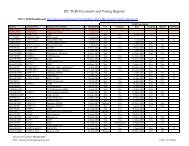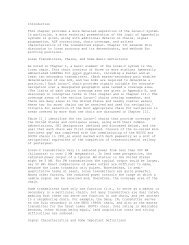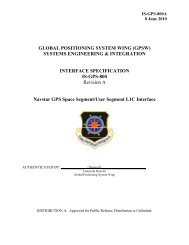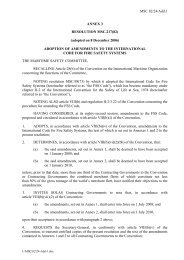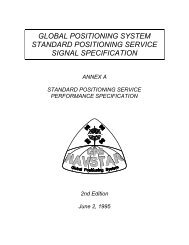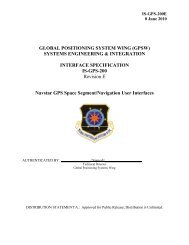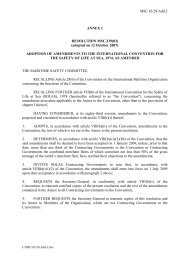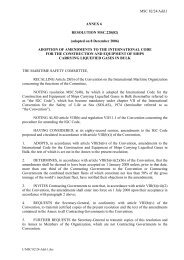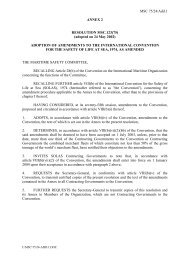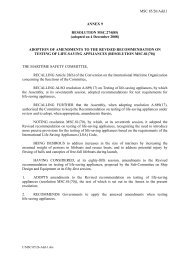- Page 4:
MSC 85/26/Add.2ANNEX 3Page 4on the
- Page 8 and 9:
MSC 85/26/Add.2ANNEX 3Page 81.5.2 C
- Page 10 and 11:
MSC 85/26/Add.2ANNEX 3Page 102 The
- Page 12 and 13:
MSC 85/26/Add.2ANNEX 3Page 12Regula
- Page 14 and 15:
MSC 85/26/Add.2ANNEX 3Page 14CHAPTE
- Page 16 and 17:
MSC 85/26/Add.2ANNEX 3Page 161.7.1
- Page 18 and 19:
MSC 85/26/Add.2ANNEX 3Page 181.7.27
- Page 20 and 21:
MSC 85/26/Add.2ANNEX 3Page 202.2 Lo
- Page 22 and 23:
MSC 85/26/Add.2ANNEX 3Page 223.3 He
- Page 24 and 25:
MSC 85/26/Add.2ANNEX 3Page 24Sectio
- Page 26 and 27:
MSC 85/26/Add.2ANNEX 3Page 26FORM F
- Page 28 and 29:
MSC 85/26/Add.2ANNEX 3Page 28.3 com
- Page 30 and 31:
MSC 85/26/Add.2ANNEX 3Page 304.7 Ex
- Page 32 and 33:
MSC 85/26/Add.2ANNEX 3Page 325.4.2
- Page 34 and 35:
MSC 85/26/Add.2ANNEX 3Page 34Sectio
- Page 36 and 37:
MSC 85/26/Add.2ANNEX 3Page 36the ca
- Page 38 and 39:
MSC 85/26/Add.2ANNEX 3Page 38Sectio
- Page 40 and 41:
MSC 85/26/Add.2ANNEX 3Page 409.3.1.
- Page 42 and 43:
MSC 85/26/Add.2ANNEX 3Page 429.3.3
- Page 44 and 45:
MSC 85/26/Add.2ANNEX 3Page 449.3.4
- Page 46 and 47:
MSC 85/26/Add.2ANNEX 3Page 46Sectio
- Page 48 and 49:
MSC 85/26/Add.2ANNEX 3Page 4810.8 S
- Page 50 and 51:
MSC 85/26/Add.2ANNEX 3Page 50- prep
- Page 52 and 53:
MSC 85/26/Add.2ANNEX 3Page 52Sectio
- Page 54 and 55:
MSC 85/26/Add.2ANNEX 3Page 5413.2.4
- Page 56 and 57:
MSC 85/26/Add.2ANNEX 3Page 56APPEND
- Page 58 and 59:
MSC 85/26/Add.2ANNEX 3Page 58ALUMIN
- Page 60 and 61:
MSC 85/26/Add.2ANNEX 3Page 60ALUMIN
- Page 62 and 63:
MSC 85/26/Add.2ANNEX 3Page 62ALUMIN
- Page 64 and 65:
MSC 85/26/Add.2ANNEX 3Page 64ALUMIN
- Page 66 and 67:
MSC 85/26/Add.2ANNEX 3Page 66VENTIL
- Page 68 and 69:
MSC 85/26/Add.2ANNEX 3Page 68CLEAN-
- Page 70 and 71:
MSC 85/26/Add.2ANNEX 3Page 70VENTIL
- Page 72 and 73:
MSC 85/26/Add.2ANNEX 3Page 72PRECAU
- Page 74 and 75:
MSC 85/26/Add.2ANNEX 3Page 74AMMONI
- Page 76 and 77:
MSC 85/26/Add.2ANNEX 3Page 76Approp
- Page 78 and 79:
MSC 85/26/Add.2ANNEX 3Page 78STOWAG
- Page 80 and 81:
MSC 85/26/Add.2ANNEX 3Page 80EMERGE
- Page 82 and 83:
MSC 85/26/Add.2ANNEX 3Page 82HOLD C
- Page 84 and 85:
MSC 85/26/Add.2ANNEX 3Page 84AMMONI
- Page 86 and 87:
MSC 85/26/Add.2ANNEX 3Page 86Prior
- Page 88 and 89:
MSC 85/26/Add.2ANNEX 3Page 88AMMONI
- Page 90 and 91:
MSC 85/26/Add.2ANNEX 3Page 90ANTIMO
- Page 92 and 93:
MSC 85/26/Add.2ANNEX 3Page 92CLEAN-
- Page 94 and 95:
MSC 85/26/Add.2ANNEX 3Page 94CARRIA
- Page 96 and 97:
MSC 85/26/Add.2ANNEX 3Page 96BIOSLU
- Page 98 and 99:
MSC 85/26/Add.2ANNEX 3Page 98BORAX,
- Page 100 and 101:
MSC 85/26/Add.2ANNEX 3Page 100CLEAN
- Page 102 and 103:
MSC 85/26/Add.2ANNEX 3Page 1024. Sm
- Page 104 and 105:
MSC 85/26/Add.2ANNEX 3Page 104.4 th
- Page 106 and 107:
MSC 85/26/Add.2ANNEX 3Page 1062.2.3
- Page 108 and 109:
MSC 85/26/Add.2ANNEX 3Page 108DISCH
- Page 110 and 111:
MSC 85/26/Add.2ANNEX 3Page 110CARBO
- Page 112 and 113:
MSC 85/26/Add.2ANNEX 3Page 112CARRI
- Page 114 and 115:
MSC 85/26/Add.2ANNEX 3Page 114VENTI
- Page 116 and 117:
MSC 85/26/Add.2ANNEX 3Page 116CARRI
- Page 118 and 119:
MSC 85/26/Add.2ANNEX 3Page 118CHARC
- Page 120 and 121:
MSC 85/26/Add.2ANNEX 3Page 120CHOPP
- Page 122 and 123:
MSC 85/26/Add.2ANNEX 3Page 122CHROM
- Page 124 and 125:
MSC 85/26/Add.2ANNEX 3Page 124CLAYD
- Page 126 and 127:
MSC 85/26/Add.2ANNEX 3Page 126LOADI
- Page 128 and 129:
MSC 85/26/Add.2ANNEX 3Page 1282.2 A
- Page 130 and 131:
MSC 85/26/Add.2ANNEX 3Page 130.2 Pe
- Page 132 and 133:
MSC 85/26/Add.2ANNEX 3Page 1322.2 S
- Page 134 and 135:
MSC 85/26/Add.2ANNEX 3Page 1342.7.1
- Page 136 and 137:
MSC 85/26/Add.2ANNEX 3Page 136PRECA
- Page 138 and 139:
MSC 85/26/Add.2ANNEX 3Page 138CARRI
- Page 140 and 141:
MSC 85/26/Add.2ANNEX 3Page 140COKE
- Page 142 and 143:
MSC 85/26/Add.2ANNEX 3Page 142COLEM
- Page 144 and 145:
MSC 85/26/Add.2ANNEX 3Page 144COPPE
- Page 146 and 147:
MSC 85/26/Add.2ANNEX 3Page 146VENTI
- Page 148 and 149:
MSC 85/26/Add.2ANNEX 3Page 148DIAMM
- Page 150 and 151:
MSC 85/26/Add.2ANNEX 3Page 150DIREC
- Page 152 and 153:
MSC 85/26/Add.2ANNEX 3Page 152Appro
- Page 154 and 155:
MSC 85/26/Add.2ANNEX 3Page 154EMERG
- Page 156 and 157:
MSC 85/26/Add.2ANNEX 3Page 156HOLD
- Page 158 and 159:
MSC 85/26/Add.2ANNEX 3Page 158The s
- Page 160 and 161:
MSC 85/26/Add.2ANNEX 3Page 160EMERG
- Page 162 and 163:
MSC 85/26/Add.2ANNEX 3Page 162WEATH
- Page 164 and 165:
MSC 85/26/Add.2ANNEX 3Page 164Any c
- Page 166 and 167:
MSC 85/26/Add.2ANNEX 3Page 166EMERG
- Page 168 and 169:
MSC 85/26/Add.2ANNEX 3Page 168FELSP
- Page 170 and 171:
MSC 85/26/Add.2ANNEX 3Page 170FERRO
- Page 172 and 173:
MSC 85/26/Add.2ANNEX 3Page 172FERRO
- Page 174 and 175:
MSC 85/26/Add.2ANNEX 3Page 174CARRI
- Page 176 and 177:
MSC 85/26/Add.2ANNEX 3Page 176VENTI
- Page 178 and 179:
MSC 85/26/Add.2ANNEX 3Page 178(vi)
- Page 180 and 181:
MSC 85/26/Add.2ANNEX 3Page 180venti
- Page 182 and 183:
MSC 85/26/Add.2ANNEX 3Page 182(v) P
- Page 184 and 185:
MSC 85/26/Add.2ANNEX 3Page 184space
- Page 186 and 187:
MSC 85/26/Add.2ANNEX 3Page 186FISH
- Page 188 and 189:
MSC 85/26/Add.2ANNEX 3Page 188PRECA
- Page 190 and 191:
MSC 85/26/Add.2ANNEX 3Page 190FLUOR
- Page 192 and 193:
MSC 85/26/Add.2ANNEX 3Page 192FLY A
- Page 194 and 195:
MSC 85/26/Add.2ANNEX 3Page 194GRANU
- Page 196 and 197:
MSC 85/26/Add.2ANNEX 3Page 196GYPSU
- Page 198 and 199:
MSC 85/26/Add.2ANNEX 3Page 198PRECA
- Page 200 and 201:
MSC 85/26/Add.2ANNEX 3Page 200CARRI
- Page 202 and 203:
MSC 85/26/Add.2ANNEX 3Page 202CARRI
- Page 204 and 205:
MSC 85/26/Add.2ANNEX 3Page 204IRON
- Page 206 and 207:
MSC 85/26/Add.2ANNEX 3Page 206IRONS
- Page 208 and 209:
MSC 85/26/Add.2ANNEX 3Page 208LABRA
- Page 210 and 211:
MSC 85/26/Add.2ANNEX 3Page 210CLEAN
- Page 212 and 213:
MSC 85/26/Add.2ANNEX 3Page 212LIME
- Page 214 and 215:
MSC 85/26/Add.2ANNEX 3Page 214LIMES
- Page 216 and 217:
MSC 85/26/Add.2ANNEX 3Page 216EMERG
- Page 218 and 219:
MSC 85/26/Add.2ANNEX 3Page 218MAGNE
- Page 220 and 221:
MSC 85/26/Add.2ANNEX 3Page 220MAGNE
- Page 222 and 223:
MSC 85/26/Add.2ANNEX 3Page 222EMERG
- Page 224 and 225:
MSC 85/26/Add.2ANNEX 3Page 224CARRI
- Page 226 and 227:
MSC 85/26/Add.2ANNEX 3Page 226METAL
- Page 228 and 229:
MSC 85/26/Add.2ANNEX 3Page 228EMERG
- Page 230 and 231:
MSC 85/26/Add.2ANNEX 3Page 230WEATH
- Page 232 and 233:
MSC 85/26/Add.2ANNEX 3Page 232CARRI
- Page 234 and 235:
MSC 85/26/Add.2ANNEX 3Page 234PEAT
- Page 236 and 237:
MSC 85/26/Add.2ANNEX 3Page 236PEBBL
- Page 238 and 239:
MSC 85/26/Add.2ANNEX 3Page 238PERLI
- Page 240 and 241:
MSC 85/26/Add.2ANNEX 3Page 240PRECA
- Page 242 and 243:
MSC 85/26/Add.2ANNEX 3Page 242PHOSP
- Page 244 and 245:
MSC 85/26/Add.2ANNEX 3Page 244PIG I
- Page 246 and 247:
MSC 85/26/Add.2ANNEX 3Page 246PITCH
- Page 248 and 249:
MSC 85/26/Add.2ANNEX 3Page 248APPEN
- Page 250 and 251:
MSC 85/26/Add.2ANNEX 3Page 250POTAS
- Page 252 and 253:
MSC 85/26/Add.2ANNEX 3Page 252EMERG
- Page 254 and 255:
MSC 85/26/Add.2ANNEX 3Page 254PUMIC
- Page 256 and 257:
MSC 85/26/Add.2ANNEX 3Page 256CARRI
- Page 258 and 259:
MSC 85/26/Add.2ANNEX 3Page 258may b
- Page 260 and 261:
MSC 85/26/Add.2ANNEX 3Page 260QUART
- Page 262 and 263:
MSC 85/26/Add.2ANNEX 3Page 262RADIO
- Page 264 and 265:
MSC 85/26/Add.2ANNEX 3Page 264RADIO
- Page 266 and 267:
MSC 85/26/Add.2ANNEX 3Page 266RASOR
- Page 268 and 269:
MSC 85/26/Add.2ANNEX 3Page 268VENTI
- Page 270 and 271:
MSC 85/26/Add.2ANNEX 3Page 270SALT
- Page 272 and 273:
MSC 85/26/Add.2ANNEX 3Page 272SANDD
- Page 274 and 275:
MSC 85/26/Add.2ANNEX 3Page 274SAWDU
- Page 276 and 277:
MSC 85/26/Add.2ANNEX 3Page 276SCRAP
- Page 278 and 279:
MSC 85/26/Add.2ANNEX 3Page 278APPEN
- Page 280 and 281:
MSC 85/26/Add.2ANNEX 3Page 280CHARA
- Page 282 and 283:
MSC 85/26/Add.2ANNEX 3Page 282SEED
- Page 284 and 285:
MSC 85/26/Add.2ANNEX 3Page 284permi
- Page 286 and 287:
MSC 85/26/Add.2ANNEX 3Page 286CHARA
- Page 288 and 289:
MSC 85/26/Add.2ANNEX 3Page 288SEED
- Page 290 and 291:
MSC 85/26/Add.2ANNEX 3Page 290SILIC
- Page 292 and 293:
MSC 85/26/Add.2ANNEX 3Page 292DISCH
- Page 294 and 295:
MSC 85/26/Add.2ANNEX 3Page 294SODIU
- Page 296 and 297:
MSC 85/26/Add.2ANNEX 3Page 296SODIU
- Page 298 and 299: MSC 85/26/Add.2ANNEX 3Page 298STAIN
- Page 300 and 301: MSC 85/26/Add.2ANNEX 3Page 300SUGAR
- Page 302 and 303: MSC 85/26/Add.2ANNEX 3Page 302SULPH
- Page 304 and 305: MSC 85/26/Add.2ANNEX 3Page 304SULPH
- Page 306 and 307: MSC 85/26/Add.2ANNEX 3Page 306SUPER
- Page 308 and 309: MSC 85/26/Add.2ANNEX 3Page 308TACON
- Page 310 and 311: MSC 85/26/Add.2ANNEX 3Page 310TANKA
- Page 312 and 313: MSC 85/26/Add.2ANNEX 3Page 312TAPIO
- Page 314 and 315: MSC 85/26/Add.2ANNEX 3Page 314VANAD
- Page 316 and 317: MSC 85/26/Add.2ANNEX 3Page 316VERMI
- Page 318 and 319: MSC 85/26/Add.2ANNEX 3Page 318WOODC
- Page 320 and 321: MSC 85/26/Add.2ANNEX 3Page 320WOOD
- Page 322 and 323: MSC 85/26/Add.2ANNEX 3Page 322EMERG
- Page 324 and 325: MSC 85/26/Add.2ANNEX 3Page 324DISCH
- Page 326 and 327: MSC 85/26/Add.2ANNEX 3Page 326CARRI
- Page 328 and 329: MSC 85/26/Add.2ANNEX 3Page 328VENTI
- Page 330 and 331: MSC 85/26/Add.2ANNEX 3Page 3301.1.2
- Page 332 and 333: MSC 85/26/Add.2ANNEX 3Page 332Conse
- Page 334 and 335: MSC 85/26/Add.2ANNEX 3Page 334I:\MS
- Page 336 and 337: MSC 85/26/Add.2ANNEX 3Page 336Figur
- Page 338 and 339: MSC 85/26/Add.2ANNEX 3Page 338Peat
- Page 340 and 341: MSC 85/26/Add.2ANNEX 3Page 3401.2.3
- Page 342 and 343: MSC 85/26/Add.2ANNEX 3Page 342Figur
- Page 344 and 345: MSC 85/26/Add.2ANNEX 3Page 344Figur
- Page 346 and 347: MSC 85/26/Add.2ANNEX 3Page 346Figur
- Page 350 and 351: MSC 85/26/Add.2ANNEX 3Page 350.2 De
- Page 352 and 353: MSC 85/26/Add.2ANNEX 3Page 3522 Tes
- Page 354 and 355: MSC 85/26/Add.2ANNEX 3Page 3542.1.5
- Page 356 and 357: MSC 85/26/Add.2ANNEX 3Page 356and a
- Page 358 and 359: MSC 85/26/Add.2ANNEX 3Page 3583.1.2
- Page 360 and 361: MSC 85/26/Add.2ANNEX 3Page 3604 Tro
- Page 362 and 363: MSC 85/26/Add.2ANNEX 3Page 3624.2.2
- Page 364 and 365: MSC 85/26/Add.2ANNEX 3Page 364the t
- Page 366 and 367: MSC 85/26/Add.2ANNEX 3Page 36612345
- Page 368 and 369: MSC 85/26/Add.2ANNEX 3Page 368APPEN
- Page 370 and 371: MSC 85/26/Add.2ANNEX 3Page 370MATER
- Page 372 and 373: MSC 85/26/Add.2ANNEX 3Page 372MATER
- Page 374 and 375: MSC 85/26/Add.2ANNEX 3Page 374MATER
- Page 376: MSC 85/26/Add.2ANNEX 3Page 376MATER




